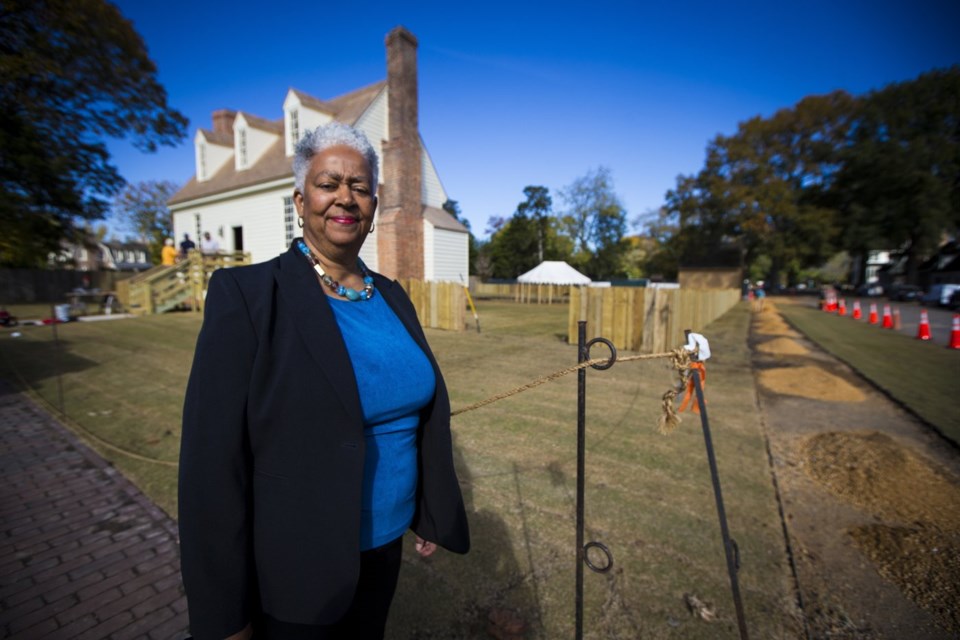WILLIAMSBURG, Va. (AP) — A Virginia museum has nearly finished restoring the , where hundreds of mostly enslaved students learned to read through a curriculum that justified slavery.
The museum, Colonial Williamsburg, also has identified more than 80 children who lined its pinewood benches in the 1760s.
They include Aberdeen, 5, who was enslaved by a saddle and harness maker. Bristol and George, 7 and 8, were owned by a doctor. Phoebe, 3, was the property of local tavern keepers.
Another student, Isaac Bee, later emancipated himself. In newspaper ads seeking his capture, his enslaver warned Bee “can read.”
The museum dedicated the Williamsburg Bray School at a large ceremony on Friday, with plans to open it for public tours this spring. tells the story of Virginia’s colonial capital through interpreters and hundreds of restored buildings.
Smithsonian Institution Secretary Lonnie Bunch told the crowd outside the refurbished school that it was one of the most important historic moments of the last decade.
“History is an amazing mirror,” Bunch added. “It’s a mirror that challenges us and reminds us that, despite what we’ve achieved, despite all our ideals, America still is a work in progress. But oh, what an amazing work it is."
The Cape Cod-style home was built in 1760 and still contains much of its original wood and brick. It will anchor a complicated story about race and education, but also resistance, before the American Revolution.
The school rationalized slavery within a religious framework and encouraged children to accept their fates as God’s plan. And yet, becoming literate also gave them more agency. The students went on to share what they learned with family members and others who were enslaved.
“We don’t shy away from the fact that this was a pro-slavery school,” said Maureen Elgersman Lee, director of William & Mary’s Bray School Lab, a partnership between the university and museum.
But she said the school takes on a different meaning in the 21st century.
“It’s a story of resilience and resistance," Lee said. "And I put the resilience of the Bray School on a continuum that brings us to today."
To underscore the point, the lab has been seeking descendants of the students, with some success.
They include Janice Canaday, 67, who also is the museum's African American community engagement manager. Her lineage traces back to the students Elisha and Mary Jones.
“It grounds you,” said Canaday, who grew up feeling little connection to history. “That’s where your power is. And those are the things that give you strength — to know what your family has come through.”
The Bray School was established in Williamsburg and other colonial cities at the recommendation of . He was a member of a London-based Anglican charity that was named after Thomas Bray, an English clergyman and philanthropist.
The Bray School was exceptional for its time. Although Virginia waited until the 1800s to impose anti-literacy laws, white leaders across much of Colonial America forbid educating enslaved people, fearing literacy would encourage them to seek freedom.
The white teacher at the Williamsburg school, , taught an estimated 300 to 400 students, whose ages ranged from 3 to 10. The school closed with her death in 1774.
The schoolhouse became a private home before it was incorporated into William & Mary’s growing campus. The building was moved and expanded for various purposes, including student housing.
Historians identified the structure in 2020 through a scientific method that examines tree rings in lumber. Last year, it was transported to Colonial Williamsburg, which includes parts of the original city.
The museum and university have focused on restoring the schoolhouse, researching its curriculum and finding descendants of former students.
The lab has been able to link some people to the Jones and Ashby families, two free Black households that had students in the school, said Elizabeth Drembus, the lab's genealogist.
But the effort has faced steep challenges: Most enslaved people were stripped of their identities and separated from their families, so there are limited records. And only three years of school rosters have survived.
Drembus is talking to people in the region about their family histories and working backward. She also is sifting through 18th-century property records, tax documents and enslavers' diaries.
“When you’re talking about researching formerly enslaved people, records were kept very differently because they weren't considered people,” Drembus said.
Researching the curriculum has been easier. The English charity catalogued the books it sent to the schools, said Katie McKinney, an associate curator of maps and prints at the museum.
Materials include a small spelling primer, a copy of which was located in Germany, that begins with the alphabet and moves on to syllables, such as “Beg leg meg peg."
Students also received a more sophisticated speller, bound in sheepskin, as well as the Book of Common Prayer and other Christian texts.
Meanwhile, the schoolhouse has been mostly restored. About 75% of the original floor has survived, allowing visitors to walk where the children and teacher placed their feet.
Canaday, whose familial roots include two Bray School students, wondered on a recent visit if any of the children “felt safe in here, whether they felt loved.”
Canaday noted that the teacher, Wager, was the mother of at least two kids.
“Did some of her mothering bleed over into what she showed those children?” Canaday said. “There are moments when we forget to go by the rules and humanity takes over. I wonder how many times that happened in these spaces."
Ben Finley, The Associated Press



